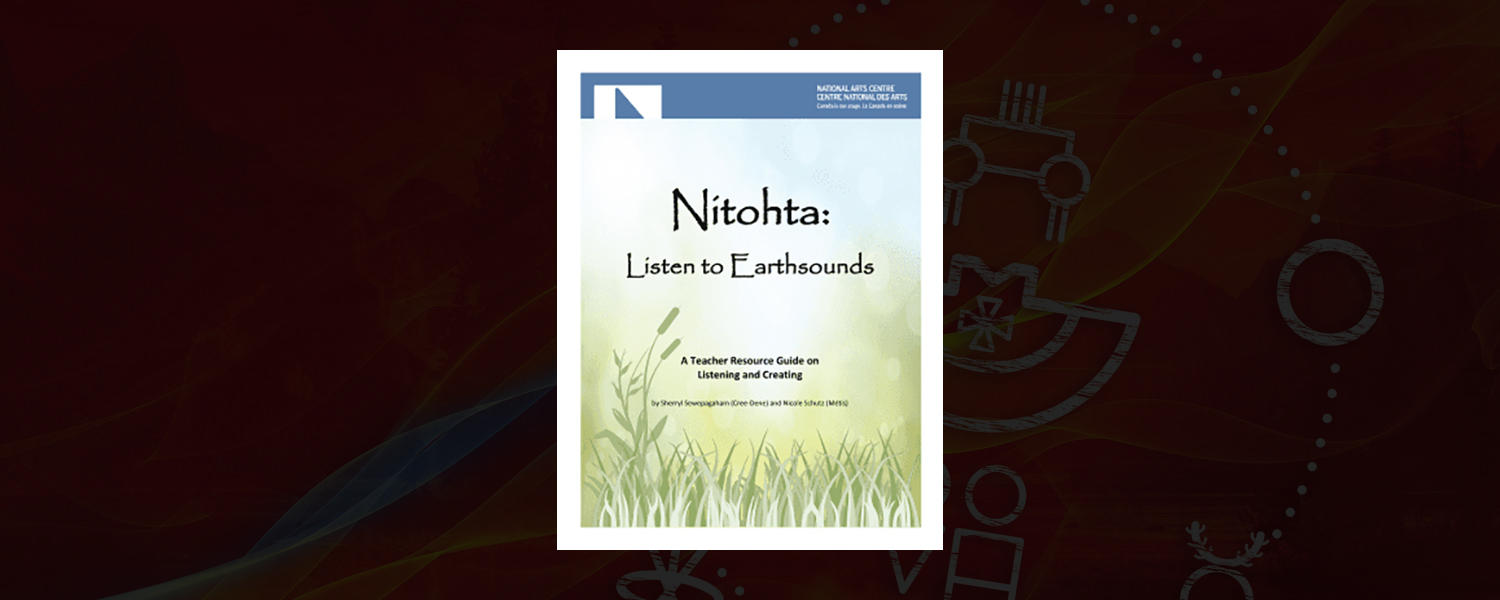
Nítohta: Listen to Earthsounds
by Nicole Schutz & Sherryl Sewepagaham
Description:
Publisher's description (National Arts Centre, n.d.):
A teacher guide on listening and creating by Sherryl Sewepagaham (Cree-Dene) and Nicole Schutz (Métis). This resource is created from an Indigenous perspective to encourage and inspire students to be creative and to build a relationship with their environment through music. Please visit this link to download the teacher resource https://naccna-assets.s3.amazonaws.com/nitohta_guide_eng_final.pdf other resources are listed in the lesson plan below.
Publisher biographies (National Arts Centre):
Sherryl Sewepagaham is of Cree-Dene ancestry and is from the Little Red River Cree Nation in northern Alberta. She holds a Bachelor of Education from the University of Alberta and a Level III Orff certification, and has worked as an elementary music teacher and teacher-consultant in Edmonton, AB for 14 years. Sherryl is a 19-year member of the 2006 Juno-nominated trio, Asani, and brings her love of traditional drum songs to the students she works with and to the Indigenous education programs she creates. Currently living in Vancouver, BC with her 13-year-old son and dog, Sherryl is completing the final Internship phase of a Bachelor of Music Therapy degree and will add the therapeutic and healing aspect of music into her practice while continuing to work on various education projects. She provides education workshops as an Artist-In-Residence in BC and Alberta schools and is always creating programs and composing new songs to share with teachers and students.
Nicole Schutz has called Edmonton, Alberta home for 20 years and lives there with her husband and 10-year-old son. She has been a music specialist with Edmonton Public Schools for 15 years and has led several children’s choirs and Orff instrument ensemble groups. She received a Bachelor of Arts and a Bachelor of Education After Degree from Concordia University of Edmonton and is currently studying a Masters of Education in Music Education at the University of Alberta. Nicole also holds a Level III Orff certification from Carl Orff Canada and a certificate in World Music Pedagogy from the Smithsonian Institute. She has presented on topics of World music and Indigenous music within her school district and city. Nicole was born and raised in Prince Albert, Saskatchewan and is Métis. Her family came from Batoche, Saskatchewan before, during, and long after the Resistance of 1885. Nicole enjoys learning about her Métis heritage by learning to play the fiddle and creating flower beadwork.
Resource format: PDF, MP3 recordings
Age recommendation: grades K-12
Keywords: First Nations, Métis, Michif, Cree, Dene, Blackfoot, nature, dance, drama, Indigenous arts, storytelling, music, improvisation, poetry, environmentalism, outdoors, Four Directions, oral tradition, languages, celebrations, ceremony, interconnectedness, poetry, teacher resource, elementary music, American Sign Language, A Tribe Called Red, Lesson plans, painting, Alex Janvier, Medicine Wheel, Singing, rhythm, partner songs, playing instruments, speech ostinato, language learning, movement, Composing, ABA (ternary) form, creative musical notation, creative writing, word painting, personal reflection, appreciating nature, identify and compare sounds (digital vs. natural), expression, creating experimental sounds, playing instruments
Year of publication: n.d.
Publisher information: National Arts Centre
Teaching and Learning Ideas
Our team collaborated with new teachers, alumni of the Werklund School of Education’s Bachelor of Education program, to create teaching and learning plans for texts in this website. With audiences ranging from Pre-Kindergarten to Post-Secondary, lesson plans across this resource address a wide range of school subject areas, inclusive approaches, and Indigenous education topics, such as the revitalization of Indigenous languages. As this website was designed with Undergraduate Programs in Education instructors, as well as teachers in mind, connections to UPE courses have been flagged on each lesson plan. These lessons are intended as a starting place for educators, to help you envision ways in which you might bring Indigenous literatures, as well as ways of knowing, being, and doing, into your teaching contexts. Please adapt, use, and share these lessons in ways that are generative for your teaching practice. We offer our sincere thanks to the dozens of new teachers who gifted us with these creative ideas!
Return to Search for Resources
